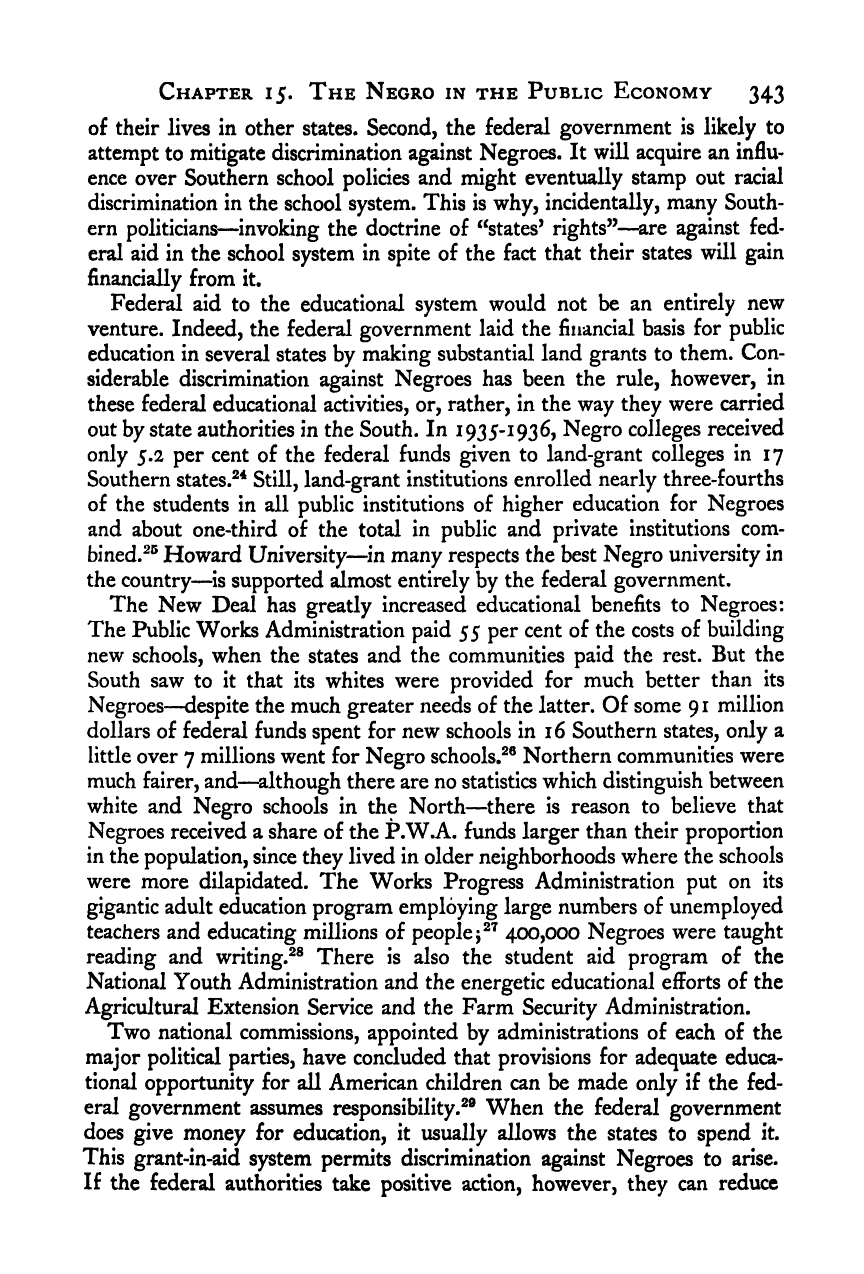Note: Gunnar Myrdal died in 1987, less than 70 years ago. Therefore, this work is protected by copyright, restricting your legal rights to reproduce it. However, you are welcome to view it on screen, as you do now. Read more about copyright.
Full resolution (TIFF) - On this page / på denna sida - IV. Economics - 15. The Negro in the Public Economy - 3. Education

<< prev. page << föreg. sida << >> nästa sida >> next page >>
Below is the raw OCR text
from the above scanned image.
Do you see an error? Proofread the page now!
Här nedan syns maskintolkade texten från faksimilbilden ovan.
Ser du något fel? Korrekturläs sidan nu!
This page has never been proofread. / Denna sida har aldrig korrekturlästs.
Chapter 15. The Negro in the Public Economy 343
of their lives in other states. Second, the federal government is likely to
attempt to mitigate discrimination against Negroes. It will acquire an influ-
ence over Southern school policies and might eventually stamp out racial
discrimination in the school system. This is why, incidentally, many South-
ern politicians—invoking the doctrine of ^^states^ rights”—^are against fed-
eral aid in the school system in spite of the fact that their states will gain
financially from it.
Feder^ aid to the educational system would not be an entirely new
venture. Indeed, the federal government laid the financial basis for public
education in several states by making substantial land grants to them. Con-
siderable discrimination against Negroes has been the rule, however, in
these federal educational activities, or, rather, in the way they were carried
out by state authorities in the South. In 1935-1936, Negro colleges received
only 5.2 per cent of the federal funds given to land-grant colleges in 17
Southern states.^^ Still, land-grant institutions enrolled nearly three-fourths
of the students in all public institutions of higher education for Negroes
and about one-third of the total in public and private institutions com-
bined.^® Howard University—^in many respects the best Negro university in
the country—is supported sJmost entirely by the federal government.
The New Deal has greatly increased educational benefits to Negroes:
The Public Works Administration paid 55 per cent of the costs of building
new schools, when the states and the communities paid the rest. But the
South saw to it that its whites were provided for much better than its
Negroes—despite the much greater needs of the latter. Of some 91 million
dollars of federal funds spent for new schools in 16 Southern states, only a
little over 7 millions went for Negro schools.^® Northern communities were
much fairer, and—^although there are no statistics which distinguish between
white and Negro schools in the North—there is reason to believe that
Negroes received a share of the P.W.A. funds larger than their proportion
in the population, since they lived in older neighborhoods where the schools
were more dilapidated. The Works Progress Administration put on its
gigantic adult education program employing large numbers of unemployed
teachers and educating millions of people 4CX),000 Negroes were taught
reading and writing.^® There is also the student aid program of the
National Youth Administration and the energetic educational efforts of the
Agricultural Extension Service and the Farm Security Administration.
Two national commissions, appointed by administrations of each of the
major political parties, have concluded that provisions for adequate educa-
tional opportunity for all American children can be made only if the fed-
eral government assumes responsibility.^® When the federal government
does give money for education, it usually allows the states to spend it.
This grant-in-aid system permits discrimination against Negroes to arise.
If the federal authorities take positive action, however, they can reduce
<< prev. page << föreg. sida << >> nästa sida >> next page >>